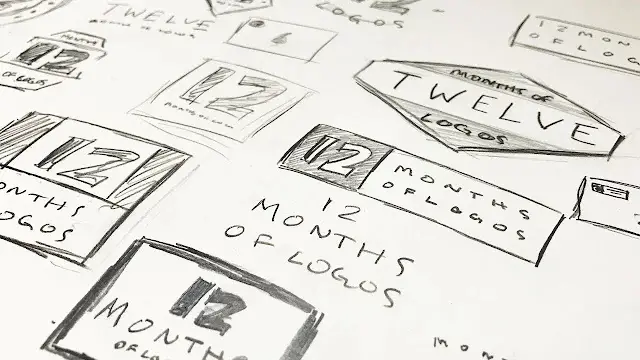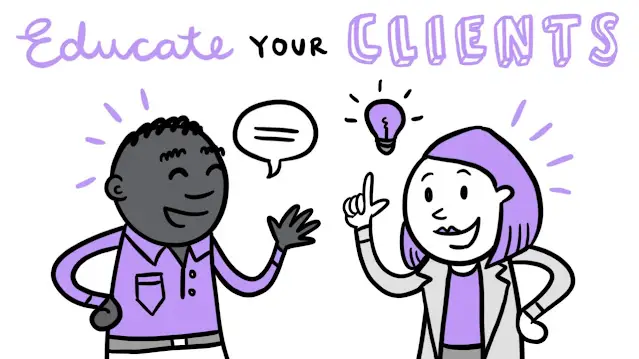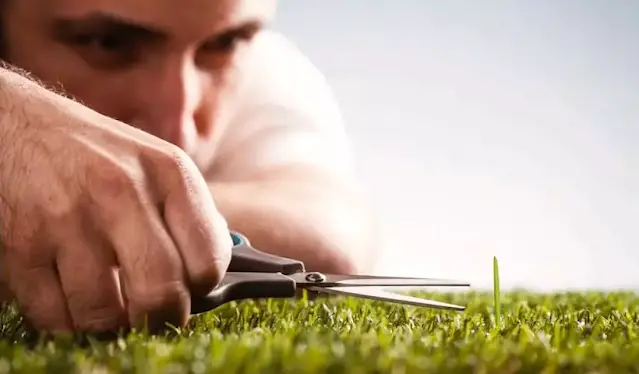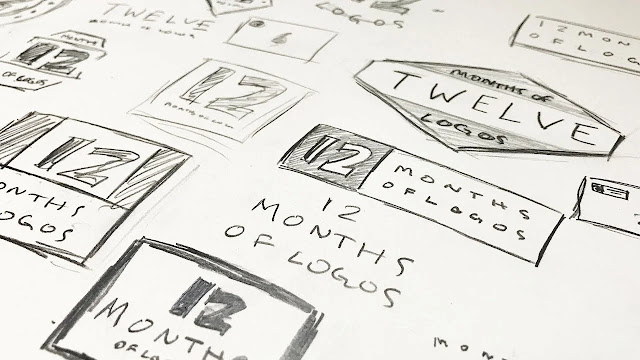When first starting out graphic designing you are excited and eager to start showing the world your creative side. But most beginners are suddenly overwhelmed by the reality of this industry.
They start to understand that it’s not a smooth sailing journey but a bumpy road.
Most beginners quit as the reality doesn’t match their expectations but what they don’t realize is that these are things all graphic designers go through sooner or later.
It’s through mistakes you actually can grow. You have to get bad in order to get good.
Paula Scher
Here are 11 essential lessons graphic designers will soon realize in this career.
1. Never Overcommit

As beginners we are overly excited when getting our first client that we want to make the best impression possible. You want to show the client you are good at what you do so you try to impress them trying to deliver the highest quality in the shortest time.
The client might ask you how long it could take you or try to give you a short deadline, as business owners want to get the most value in the littlest time. But if you don’t have a lot of industry experience you might not know your own capacity.
You should always under promise and over deliver. If it takes you 2 weeks to design a logo give a deadline of 3 weeks, this way you can deliver before the deadline and gain your client’s trust.
2. The First Concept Will Be Bad
You have to know that the first few designs you crank out will be absolute trash. The concepts that you design will be terrible because you simply haven’t experimented much. Graphic designing requires you to dish out loads of ideas and put them on a piece of paper before getting the one that sticks.
Think of your brain and its thoughts.
An average person has around 6000 thoughts per day, are they all good, happy and positive thoughts? No, most of them are negative and catastrophic but you have to filter them out.
Just like that you have to make several concepts before you start getting better and more creative with each new concept.
When I was working with a local client of mine I was given the task to design their new brand.
Here is my initial concept for their logo:

And this is the final logo we came up with:


3. Not Sketching First

It’s always tempting to jump on your computer and start designing however you need to get your ideas out first.
To do that, you have to put all your ideas on a piece of paper by sketching them out.
You don’t have to be an artist to sketch out some initial concepts but these will be a helpful reference to filter out the good ideas from the bad ones.
Once you have a good few sketches you can take a picture, transfer them to your computer and use them as a reference for the actual graphic design.
4. Your Interests and The Client’s Interests are different
This one is a harsh reality to most designers who have a passion for design. Most designers have a signature style which they use in their designs however they ignore the client’s guidelines.
Even though you’re the designer, it’s not your brand. In the beginning, you don’t have much experience to carry out judgements on what would work better for the client or not.
In the start, you should try to learn how to communicate with clients, find out their needs and fulfil them. Remember, it isn’t about you.
5. Not Educating Your Clients

This may be a daunting task for beginners as you may consider yourself the authority in the conversation.
Educating your clients means guiding them through the process and helping them make wise business decisions. When you present a design you don’t just send them a PDF and ask “how is it?”
You are the designer not them. If they like the color red and want it in their design but you know that it won’t work well with their brand, tell them. Here’s what this conversation might look like:
Client: “I like the design but I want to see the logo in a red color.”
Designer:” A red color won’t suit your brand as the red color suggests excitement whereas your brand is sophisticated and calming. The color blue and white suggest both these things nicely.”
The designer had to explain to the client why some colors work and some don’t. A good designer implements color theory and psychology in his design for the brand to resonate with its audience.
6. Trying to Be a Perfectionist

Perfectionism is a trap I have fell for time and time again. There is no such thing as the perfect design as design is subjective, some designs work, some don’t.
The hardest thing isn’t to stop being a perfectionist rather identifying if you are one. This is complicated as a graphic designer needs to have a sharp eye for details but at the same time they shouldn’t stress over small things.
The trap comes where you think you just want to give high-quality work but are trying to be perfect.
- Perfectionism makes sure you get nothing done as you allow yourself to only make the highest quality stuff
- It can make you quit on a project halfway as you won’t be able to make it “perfect”
- It can lead to stress when you fret on the tiny details no one will notice
To tackle perfectionism you can:
- Make as many rough concepts as you can without judgement
- Learn what requires your attention and what doesn’t
- Focus on the positives
- Experiment often
Perfectionism robs you of your time and sleep. Try to manage it.
7. It’s Not All About Looking Good

You designed a poster for your client and it looks beautiful. Vibrant colors, smooth consistent strokes, amazing illustrations and great typography, all those elements coming together make your eyes sparkle and proud of your work.
Here’s the issue;
It has no meaning.
Who is it trying to attract?
What is it conveying to the audience?
What relevance does it have to the brand?
Your poster is unable to answer those questions because, quite frankly, you don’t know either. You don’t know why you used some colors over another, you don’t know what you’re trying to convey nor do you know if it resonates with your audience or not.
You focused so much on catching people’s attention that you don’t know what to do after you have their attention.
In graphic designing, you have to think beyond the visual aspect of design and think of the emotional and psychological connection with your audience.
8. Not Asking A lot of Questions

Let’s say you score a client and this the brief they give you regarding their company:
“I want a logo done for my personal finance business that targets retired soldiers. I want the logo to be bold and have bright colors to attract the viewer’s eye and plan on marketing my business on social media.”
Now, you have a design brief, do you start designing?
No!
You don’t know what their goals are, you don’t know what they actually do, and you don’t know their interests.
The worst thing most beginners who are eager to start working will do is create concepts according to the brief and send it to the client.
Just for them to reject it every single time. Because it just doesn’t work for their brand.
This will cause you to keep going back and forth with the client because you have no idea what would be a good fit for them and they don’t know how to tell you.
When the client doesn’t mention enough details in his design brief it’s time to take out your notepad and start asking questions.
Here’s a list of questions that DesignInc. Compiled that they would ask their clients:
- Information about the company, what they do, their product/service/solution
- The market & the competition
- The profile of the ideal recipient/buyer/customer
- What makes them different? MSPs, USPs
- Expectations -what are they really trying to achieve with this project?
- The profile – how would they like others to perceive them?
- The project message/theme
- Are there any corporate guidelines?
- Examples of similar things they like
- Examples of things they have done before
- Budgets & deadline
- Technical Spec
These might seem like a lot but these questions are beneficial for both the client and the designer to get the best design done of the business.
9. Not Being Confident Enough

Unfortunately most beginner graphic designers are desperate for work. They just want to see the fruits of their labor and are willing to beg and plead for work.
This doesn’t work as no one wants to work with a desperate designer who can’t learn to respect his own time and value (scammers will love you though.)
You have to find a good balance of being confident in your skills and not come off as arrogant.
Here’s an extract from a popular interview of Steve Jobs when he was working with American graphic designer Paul Rand:
“I asked him if he would come up with a few options. And he said, ‘No, I will solve your problem for you, and you will pay me. And you don’t have to use the solution — if you want options, go talk to other people. But I’ll solve your problem for you the best way I know how, and you use it or not, that’s up to you — you’re the client — but you pay me.’
[…]
He’s a very deep, thoughtful person who’s tried to express in every part of his life what his principles are. And you don’t meet so many people like that today.”
Steve Jobs
That’s how much confidence matters.
10. You Don’t Need Any Fancy Equipment

When I first started out, I always kept on making excuses to not start.
“I don’t have a good PC, I don’t have a graphics tablet, I don’t have a good home-office” etc.
One day, I finally decided to start and didn’t stop since.
And now, with the help of this blog, I try to convince other designers that they don’t need that stuff either.
Spoiler Alert: You don’t need that fancy shmancy stuff when first starting out.
11. Master the Basics

As a curious designer it’s tempting to want to learn all about the 70 different tools (and counting) in Photoshop or try figuring out the pathfinder tools in Illustrator.
However, majority of the times you don’t need these tools, just the essential ones.
Keep in mind these tools were developed to cater to the needs of multiple professions, so if you’re a logo designer you might not need the same tools as photographers.
Most professionals might agree when I say all you need in order to be a successful designer is to master the basics.
These basics include:
- Branding Psychology
- Color theory
- Typography
- Layout and Compositions
You can also check out this helpful guide compiled by 99designs which covers the basics very well.
These are lessons that every graphic designer will learn in their career. Some of them might seem harsh but I didn’t make this list in order to discourage from you pursuing this career.
Rather you should be aware of these so you can face them bravely later on your path of success.
Until then, keep designing!
3. You Need to Sketch First

It’s always tempting to jump on your computer and start designing however you need to get your ideas out first.
To do that, you have to put all your ideas on a piece of paper by sketching them out.
You don’t have to be an artist to sketch out some initial concepts but these will be a helpful reference to filter out the good ideas from the bad ones.
Once you have a good few sketches you can take a picture, transfer them to your computer and use them as a reference for the actual graphic design.
4. Your Interests and The Client’s Interests are different
This one is a harsh reality to most designers who have a passion for design. Most designers have a signature style which they use in their designs however they ignore the client’s guidelines.
Even though you’re the designer, it’s not your brand. In the beginning you don’t have much experience to carry out judgements on what would work better for the client as you simply don’t have the experience.
In the start you should try to learn how to communicate with clients, find out their needs and fulfil them. Remember, it isn’t about you.
5. You Have to Educate your Clients

This may be a daunting task for beginners as you may consider yourself the authority in the conversation.
Educating your clients means guiding them through the process and helping them make wise business decisions. When you present a design you don’t just send them a PDF and ask “how is it?”
You are the designer not them. If they like the color red and want it in their design but you know that it won’t work well with their brand, tell them. Here’s what this conversation might look like:
Client: “I like the design but I want to see the logo in a red color.”
Designer:” A red color won’t suit your brand as the red color suggests excitement whereas your brand is sophisticated and calming. The color blue and white suggest both these things nicely.”
The designer had to explain to the client why some colors work and some don’t. A good designer implements color theory and psychology in his design for the brand to resonate with its audience.
6. Perfectionism is your Enemy

Perfectionism is a trap I have fell for time and time again. There is no such thing as the perfect design as design is subjective, some designs work, some don’t.
The hardest thing isn’t to stop being a perfectionist rather identifying if you are one. This is complicated as a graphic designer needs to have a sharp eye for details but at the same time they shouldn’t stress over small things.
The trap comes where you think you just want to give high-quality work but are trying to be perfect.
- Perfectionism makes sure you get nothing done as you allow yourself to only make the highest quality stuff
- It can make you quit on a project halfway as you won’t be able to make it “perfect”
- It can lead to stress when you fret on the tiny details no one will notice
To tackle perfectionism you can:
- Make as many rough concepts as you can without judgement
- Learn what requires your attention and what doesn’t
- Focus on the positives
- Experiment often
Perfectionism robs you of your time and sleep try to manage it.
7. It’s Not All About Looking Good

Here’s the issue;
It has no meaning.
Who is it trying to attract?
What is it conveying to the audience?
What relevance does it have to the brand?
Your poster is unable to answer those questions because, quite frankly, you don’t know either. You don’t know why you used some colors over another, you don’t know what you’re trying to convey nor do you know if it resonates with your audience or not.
You focused so much on catching people’s attention that you don’t know what to do after you have their attention.
In graphic designing, you have to think beyond the visual aspect of design and think of the emotional and psychological connection with your audience.
8. Ask A lot of Questions

Let’s say you score a client and this the brief they give you regarding their company:
“I want a logo done for my personal finance business that targets retired soldiers. I want the logo to be bold and have bright colors to attract the viewer’s eye and plan on marketing my business on social media.”
Now, you have a design brief, do you start designing?
No!
You don’t know what their goals are, you don’t know what they actually do, and you don’t know their interests.
The worst thing most beginners who are eager to start working will do is create concepts according to the brief and send it to the client.
Just for them to reject it every single time. Because it just doesn’t work for their brand.
This will cause you to keep going back and forth with the client because you have no idea what would be a good fit for them and they don’t know how to tell you.
When the client doesn’t mention enough details in his design brief it’s time to take out your notepad and start asking questions.
Here’s a list of questions that DesignInc. Compiled that they would ask their clients:
- Information about the company, what they do, their product/service/solution
- The market & the competition
- The profile of the ideal recipient/buyer/customer
- What makes them different? MSPs, USPs
- Expectations -what are they really trying to achieve with this project?
- The profile – how would they like others to perceive them?
- The project message/theme
- Are there any corporate guidelines?
- Examples of similar things they like
- Examples of things they have done before
- Budgets & deadline
- Technical Spec
These might seem like a lot but these questions are beneficial for both the client and the designer to get the best design done of the business.
9. Confidence Sells

This doesn’t work as no one wants to work with a desperate designer who can’t learn to respect his own time and value (scammers will love you though.)
You have to find a good balance of being confident in your skills and not come off as arrogant.
Here’s an extract from a popular interview of Steve Jobs when he was working with Paul Rand and American Graphic designer:
“I asked him if he would come up with a few options. And he said, ‘No, I will solve your problem for you, and you will pay me. And you don’t have to use the solution — if you want options, go talk to other people. But I’ll solve your problem for you the best way I know how, and you use it or not, that’s up to you — you’re the client — but you pay me.’
[…]
He’s a very deep, thoughtful person who’s tried to express in every part of his life what his principles are. And you don’t meet so many people like that today.”
That’s how much confidence matters.
10. You Don’t Need Any Fancy Equipment

When I first started out, I always kept on making excuses to not start.
“I don’t have a good PC, I don’t have a graphics tablet, I don’t have a good home-office” etc.
One day, I finally decided to start and didn’t stop since.
And now, with the help of this blog, I try to convince other designers that they don’t need that stuff either.
I discussed these issues in detail in the following articles:
- Do You Need a Good PC for Starting Digital Art? | Digital Art
- Do You Need a Graphics tablet to Become a Graphic designer?
- How to Do Graphic Design on Mobile
Spoiler Alert: You don’t need that fancy shmancy stuff when first starting out.
11. Master the Basics

As a curious designer it’s tempting to want to learn all about the 70 different tools (and counting) in Photoshop or try figuring out the pathfinder tools in Illustrator.
However, majority of the times you don’t need these tools, just the essential ones.
Keep in mind these tools were developed to cater to the needs of multiple professions, so if you’re a logo designer you might not need the same tools as photographers.
Most professionals might agree when I say all you need in order to be a successful designer is to master the basics.
These basics include:
- Branding Psychology
- Color theory
- Typography
- Layout and Compositions
You can also check out this helpful guide compiled by 99designs which covers the basics very well.
These are lessons that every graphic designer will learn in their career. Some of them might seem harsh but I didn’t make this list in order to discourage from you pursuing this career.
Rather you should be aware of these so you can face them bravely later on your path of success.
Until then, keep designing!